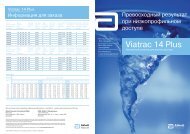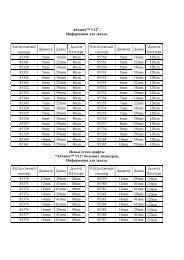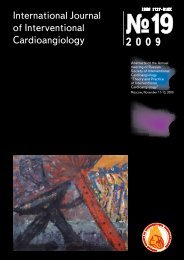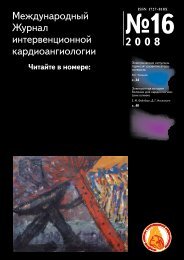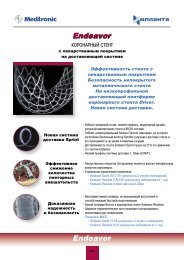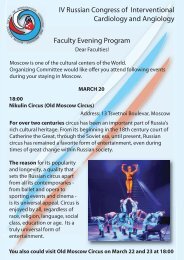International Journal of Interventional Cardioangiology
International Journal of Interventional Cardioangiology
International Journal of Interventional Cardioangiology
You also want an ePaper? Increase the reach of your titles
YUMPU automatically turns print PDFs into web optimized ePapers that Google loves.
INTERVENTIONAL CARDIOLOGY<br />
<strong>of</strong> systemic thrombolysis completion. Recording <strong>of</strong><br />
the ST elevation recurrences during ECG monitoring<br />
after reperfusion therapy completion influences the<br />
choice <strong>of</strong> the further treatment strategy.<br />
CONCLUSIONS<br />
1. Detection <strong>of</strong> sharp-pointed peak <strong>of</strong> increase in ST<br />
elevation with rapid further ST depression is highly<br />
suggestive <strong>of</strong> the efficacy <strong>of</strong> thrombolytic therapy<br />
performed. Typical pattern is characterized by<br />
the following parameters: ST segment amplitude<br />
increase to 140% and more from baseline over<br />
time not exceeding 10 minutes and restoration to<br />
initial level in not more than 15 minutes.<br />
2. Typical ST pattern recording during continuous<br />
ECG monitoring allows to reduce substantially<br />
the time <strong>of</strong> assessment <strong>of</strong> the reperfusion therapy<br />
efficacy – less than 90 minutes in all patients, less<br />
than 1 hour almost in half <strong>of</strong> patients.<br />
References:<br />
1. Management <strong>of</strong> acute myocardial infarction in patients<br />
presenting with ST-segment elevation/ ESC guidelines. Eur.<br />
Heart J., 2003, 24, 28-66.<br />
2. ACC/AHA guidelines fot the Management <strong>of</strong> Patients with<br />
ST-Elevation Myocardial Infarction. Circulation, 2004, 110,<br />
e82-e293.<br />
3. Diagnosis and treatment <strong>of</strong> patients with AMI with ST segment<br />
<strong>of</strong> ECG elevation Russian recommendations <strong>of</strong> RSCS.<br />
Moscow, 2007, p.152.<br />
4. Chesebro J.H., Katterud G., Roberts R., Borer J., Cohen<br />
L.S., Dalen J. et. al. Thrombolysis in myocardial infarction<br />
(TIMI) trial. Phase I: a comparison between intravenous tissue<br />
plasminogen activator and intravenous streptokinase. Clinical<br />
findings through hospital discharge. Circulation, 1987, 76,<br />
142-154.<br />
5. de Lemos J.A., Antman E.M., McCabe C.H.,et.al.<br />
ST-segment resolution and infarct related artery patency<br />
and flow after thrombolytic therapy. Am.J.Cardiol., 2000, 85,<br />
299-304.<br />
6. de Lemos J.A., Braunwald E. ST segment rsolution as a<br />
tool for assessing the efficacy <strong>of</strong> reperfusion therapy. J.Am.<br />
Coll.Cardiol., 2001, 38, 5, 1283-1294.<br />
7. Schroder R., Zeymer U., Wegscheider K., Neuhaus K.L.<br />
Comparison <strong>of</strong> the predictive value <strong>of</strong> ST segment elevation<br />
resolution at 90 and 180 min after start <strong>of</strong> streptokinase in<br />
acute myocardial infarction: a substudy <strong>of</strong> the Hirudin for<br />
improvement <strong>of</strong> Thrombolysis (HIT)-4 study. Eur. Heart J.,<br />
1999, 20, 1563-1571.<br />
8. I.I. Staroverov, K.L. Kotkin. Purolasa – Russian thrombolytic<br />
drug <strong>of</strong> third generation. Treatment in acute myocardial<br />
infarction. Russkij Meditsinkij Zhurnal (Kardiologia), 2004, 12,<br />
9, 3-7.<br />
9. Carmeliet E. Cardiac ionic currents and acute ischemia:<br />
from channels to arrhythmias Physiol. Rev. 1999, 79 (3),<br />
917-1017.<br />
10. Wilcox R.G. ST-segment elevation resolution – a surrogate<br />
for infarct vessel patency or myocardial perfusion, but a call<br />
for rescue? Eur.Heart J., 2001, 22, 722-724.<br />
11. ESC Guidelines for percutaneous coronary interventions<br />
Eur. Heart J., 2005, 26, 804-847.<br />
12. Johanson P., Fu Y., Goodman S.G., Dellborg M. et al. A<br />
dynamic model forecasting myocardial infarct size before,<br />
during, and after reperfusion therapy: an ASSENT-2 ECG/VCG<br />
substudy. Eur.Heart.J., 2005, 26, 1726-1733.<br />
13. Naslund U., Haggmark S., Johansson G., Reiz S.<br />
Quantification model <strong>of</strong> myocardium at risk and detection<br />
<strong>of</strong> reperfusion by dynamic vectorcardiographic ST segment<br />
monitoring in a pig occlusion-reperfusion. Cardiovasc.Res.,<br />
1993, 27, 12, 2170-2178.<br />
14. Feldman L.J., Himbert D., Juliard J.M. et. al. Reperfusion<br />
syndrome: relationship <strong>of</strong> coronary blood flow reserve to left<br />
ventricular function and infarct size. J.Am.Coll. Cardiol., 2000,<br />
35, 1162-1169.<br />
15. Andrews A., Straznicky I.T., French J.K., Green C.L., Maas<br />
A.C.P., Lund M., Kruc<strong>of</strong>f M.W., White H.D. ST-segment recovery<br />
adds to the assessment <strong>of</strong> TIMI 2 and 3 flow in predicting<br />
infarct wall motion after thrombolytic therapy. Circulation,<br />
2000, 101, 2138-2143.<br />
16. Dong J., Ndrepepa G, Schmitt C. et. Al. Early resolution<br />
<strong>of</strong> ST-segment elevation correlates with myocardial salvage<br />
assessed by Tc-99m sestamibi scintigraphy in patients with<br />
acute myocardial infarction after mechanical or thrombolytic<br />
reperfusion therapy. Circulation, 2002, 105, 2946-2949.<br />
17. Aguiar C., Ferreira J., Seabra-Gomes R. Prognostic<br />
value <strong>of</strong> continuous ST-segment monitoring in patients with<br />
non-ST-segment elevation acute coronary syndromes Ann.<br />
Noninvasive Electrocardiol., 2002, 7,1:29-39.<br />
18. Akkerhuis K.M., Maas A.C., Klootwijk P.A., Kruc<strong>of</strong>f M.W.,<br />
Meij S., Califf R.M., Simoons M.L. Recurrent ischemia during<br />
continuous 12-lead ECG-ischemia monitoring in patients with<br />
acute coronary syndromes treated with eptifibatide: relation<br />
with death and myocardial infarction. PURSUIT ECG-Ischemia<br />
Monitoring Substudy Investigators. Platelet glycoprotein IIb/<br />
IIIa in Unstable angina: Receptor Suppression Using Integrilin<br />
Therapy. J.Electrocardiol., 2000, 33, 2, 127-36.<br />
19. Jernberg T., Lindahl B., Wallentin L. ST-segment monitoring<br />
with continuous 12-lead ECG improves early risk stratification<br />
in patients with chest pain and ECG nondiagnostic <strong>of</strong><br />
acute myocardial infarction. J.Am.Coll.Cardiol., 1999, 34, 5,<br />
1413-1419.<br />
Types <strong>of</strong> ST Segment Resolution during Thrombolytic Therapy<br />
in Patients with Acute Coronary Syndrome<br />
21




